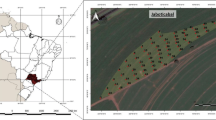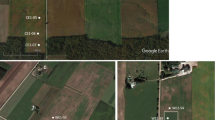Abstract
Soybean (Glycine max Merr.) is extensively grown in areas of the US Corn Belt where soils often range from relatively acid (pH < 6) to alkaline, calcareous. Iron availability decreases with increase in pH, consequently, soybean can suffer from iron deficiency chlorosis on high pH, calcareous areas of the field. The extent of those areas sometimes can be significant, but they often occur in complex and discontinuous patterns. The objective of the research was to explore how remote sensing of soybean canopies and GIS technologies could be used to map and quantitatively describe the extent of high pH, calcareous soils at field scale. Aerial images that consisted of visible red, green, blue, and near infrared bands were used to calculate green normalized difference vegetative index (GNDVI) and to guide plant and soil sampling at 10 fields during 2003 and 2004 growing seasons. Ten to 18 sampling areas were selected on each field to include a wide range in GNDVI values. Soil samples were analyzed for pH and calcium carbonate equivalent (CCE). Plant samples were used to estimate grain yields. Soil pH and CCE were significantly correlated with GNDVI values in eight and seven sites, respectively. A previously developed alkalinity stress index (ASI), which combines pH and CCE in one value, was significantly related to GNDVI at all 10 sites. Remote sensing of soybean canopy was shown to be a promising tool that can be used to quantitatively describe distribution of alkaline soils at field scale.





Similar content being viewed by others
References
Adams, M. L., Norvel, W. A., Philpot, W. D., & Peverly, J. H. (2000). Toward the discrimination of manganese, zinc, copper, and iron deficiency in ‘Bragg’ soybean using spectral detection methods. Agronomy Journal, 92, 261–268. doi:10.1007/s100870050031.
Blackmer, A. M., & Rogovska, N. P. (2001). Aerial images reveal soybean stress. Iowa Soybean Review, 12, 14–15.
Blackmer, T. M., & Schepers, J. S. (1996). Aerial photography to detect nitrogen stress in corn. Journal of Plant Physiology, 148, 440–444.
Bloom, P. R. (2000). Soil pH and pH buffering. In M. Sumner (Ed.), Handbook of soil science (pp. B-333–B-352). Boca Ranton, FL, USA: CRC press LLC.
Boellstorff, J. D. (1978). Procedure for the analysis of pebble lithology, heavy minerals, light minerals and matrix calcite-dolomite of tills (Vol. 8). Des Moines, IA, USA: Iowa Geological Survey.
Chong, C. S., Basart, J. P., Nutter, F. W., Tylka, G. L., Guan, J. (2002). Use of remote sensing to determine plant health and productivity. In M. Strojnik (Ed.), Proceedings of Infrared Spaceborne Remote Sensing IX (pp. 484–493). San Diego, CA, USA: Society of Photo-Optical Instrumentation Engineers.
Fleming, A., Chaney, R., & Coulombe, B. (1984). Bicarbonate inhibits Fe-stress response and Fe uptake-translocation of chlorosis-susceptible soybean cultivars. Journal of Plant Nutrition, 7, 699–714.
Franzen, D. W., & Richardson, J. L. (2000). Soil factors affecting iron chlorosis of soybean in the Red River Valley of North Dakota and Minnesota. Journal of Plant Nutrition, 23, 67–78.
Gates, D. M., Keedan, H. J., Schleter, J. C., & Weidner, V. R. (1965). Spectral properties of plants. Applied Optics, 4, 11–20.
Gittelson, A. A., Kaufman, Y. J., & Merzlyak, M. N. (1996). Use of a green channel in remote sensing of global vegetation from EOS-MODIS. Remote Sensing of the Environment, 58, 289–298. doi:10.1016/S0034-4257(96)00072-7.
Goos, R. J., Johnson, B. E. (2000a). Iron research in North Dakota, 1998–1999. In A. J. Schlegel (Ed.), Proceedings of Great Plains Soil Fertility Conference (pp. 341–345). Denver, CO, USA: International Plant Nutrition Institute.
Goos, R. J., & Johnson, B. E. (2000b). A Comparison of three methods for reducing iron-deficiency chlorosis in soybean. Agronomy Journal, 92, 1135–1139.
Hart, W. G., & Myers, V. I. (1968). Infrared aerial color photography for detection of populations of brown soft scale in citrus groves. Journal of Economic Entomology, 61, 617–624.
Inskeep, W., & Bloom, P. (1986). Effect of soil moisture on soil pCO2, soil solution bicarbonate, and iron chlorosis in soybeans. Soil Science Society of America Journal, 50, 946–952.
Karkosh, A. E., Walker, A. K., & Simmons, J. J. (1988). Seed treatment for control of iron-deficiency chlorosis of soybean. Crop Science, 28, 369–370.
Kumar, R., & Silva, L. (1973). Light ray tracing through a leaf cross-section. Applied Optics, 12, 2950–2954.
Loeppert, R. H. (1986). Reaction of iron and carbonates in calcareous soils. Journal of Plant Nutrition, 9, 195–214.
Ma, B. L., Dwyer, L. M., Costa, C., Cober, E. R., & Morrison, M. J. (2001). Early prediction of soybean yield from canopy reflectance measurements. Agronomy Journal, 93, 1227–1234.
Ma, B. L., Morrison, M. J., & Dwyer, L. M. (1996). Canopy light reflectance and field greenness to assess nitrogen fertilization and yield of maize. Agronomy Journal, 88, 915–920.
Mahey, R. K., Singh, R., Sidhu, S. S., & Narang, R. S. (1991). The use of remote sensing to assess the effects of water stress on wheat. Experimental Agriculture, 27, 423–430.
Mengel, K. (1994). Iron availability in plant tissues—iron chlorosis on calcareous soils. Plant and Soil, 165, 275–283. doi:10.1007/BF00008070.
Morris, D. R., Loeppert, R. H., & Moore, T. J. (1990). Indigenous soil factors influencing iron chlorosis of soybean in calcareous soils. Soil Science Society of America Journal, 54, 1329–1336.
Nikolic, M., & Romheld, V. (1999). Mechanism of Fe uptake by the leaf symplast: Is Fe inactivation in leaf a cause of Fe deficiency chlorosis? Plant and Soil, 215, 229–237. doi:10.1023/A:1004786211779.
Penas, E. J., Wiese, R. A., Elmore, R. W., Hergert, G. W., Moomaw, R. S. (1990). Soybean chlorosis studies on high pH bottomland soils. Lincoln, NE, USA: University of Nebraska Institute of Agriculture and Natural Recourses Bulletin 312.
Randall, G. W. (1981). Correcting iron chlorosis in soyabeans. Minnesota Agricultural Extension Service, Soils Fact Sheet 27 (revised), USA.
Rogovska, N., Blackmer, A. M., & Mallarino, A. P. (2007). Relationships between soybean yield, soil pH, and soil carbonate concentration. Soil Science Society of America Journal, 71, 1251–1256. doi:10.2136/sssaj2006.0235.
SAS Institute. (2002). The SAS system for Windows Vers. 8. Cary, NC, USA: SAS Institute.
Shawn, D. R., & Kelley, F. S. (2005). Evaluating remote sensing for determining and classifying soybean anomalies. Precision Agriculture, 6, 421–429. doi:10.1007/s11119-005-3681-9.
SPSS Inc. (2002). SigmaPlot 8.0 for Windows. Chicago, IL, USA: SPSS Inc.
Sripada, R. P., Heiniger, R. W., White, J. G., & Weisz, R. (2005). Aerial color infrared photography for determining late-season nitrogen requirements in corn. Agronomy Journal, 97, 1443–1451. doi:10.2134/agronj2004.0314.
Stone, M. L., Solie, J. B., Raun, W. R., Whitney, R. W., Taylor, S. L., & Ringer, J. D. (1996). Use of spectral radiance for correcting in-season fertilizer nitrogen deficiencies in winter wheat. Transactions ASABE, 39, 1623–1631.
Toler, R. W., Smith, B. D., & Harlan, J. C. (1981). Use of aerial color infrared to evaluate crop disease. Plant Disease, 65, 24–31.
Acknowledgments
The Iowa Soybean Association and John Deere & Company provided partial funding for this research. Comments and suggestions of anonymous reviewers are greatly appreciated.
Author information
Authors and Affiliations
Corresponding author
Rights and permissions
About this article
Cite this article
Rogovska, N., Blackmer, A.M. Remote sensing of soybean canopy as a tool to map high pH, calcareous soils at field scale. Precision Agric 10, 175–187 (2009). https://doi.org/10.1007/s11119-008-9087-8
Published:
Issue Date:
DOI: https://doi.org/10.1007/s11119-008-9087-8




